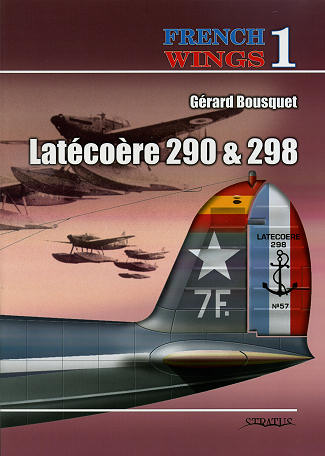 It is always a
delight to receive a book on a subject that you thought would never be done. Yet
the fine folks at Stratus publishing have managed to put together a book that I
think is really superb on an interesting subject, the French Latecoere 298 float
torpedo bomber and its predecessor, the Latecoere 290.
It is always a
delight to receive a book on a subject that you thought would never be done. Yet
the fine folks at Stratus publishing have managed to put together a book that I
think is really superb on an interesting subject, the French Latecoere 298 float
torpedo bomber and its predecessor, the Latecoere 290.
If you've not had the chance to read a Stratus book,
then you are in for a treat. Not only are they well written, but they are chock
full of photographs and color profiles based on those photographs. This one is
no exception with dozens upon dozens of well chosen image and great profiles.
We are provided with a full history of the Latecoere 298
from the inception of the idea in mid 1933, through its gestation as a working
design, the development of the prototype and its eventual entry into service
just prior to France's involvement in WWII. This is one of those planes that was
a great idea, but in the heat of battle against a modern military, the 298 just
wasn't able to properly protect itself or carry out its main mission. Many of
the planes were squandered with land bombing missions, a rather odd use of a
floatplane. They were able to do a fine job on coastal reconnaissance and though
they dropped bombs on many suspected submarines, none were confirmed as sunk.
Even after the French armistice, the 298 continued to be
built for the Vichy Navy and were mostly based in either Southern France,
Corsica or the North African colonies. A brief detachment was made to the Levant
against the British, but with apparently little enthusiasm. After the North
African invasion by the Allies, the 298 continued to perform its mission. Even
post war the plane played a part in the new French Navy, finally retiring in
1950. Though several planes were tested by the Germans, they were never used by
any other power other than the French.
The other part of the book is on the Latecoere 290, the
predecessor to the 298. This was truly a plane that was not effective, though it
did help to develop strategies and techniques for the use of torpedo float
planes. Not that many were built and many of those built succumbed to crashes,
taking several crews with it. It was eventually relegated to secondary and
tertiary duties once the 298 was in unit service.
In addition to a history of the types, there is a
section on the various camouflage and markings schemes worn by these planes.
None of these aircraft survived, but thanks to Stratus, we now have a fine
reference book in English on this important French naval type. Like all of
Stratus' books, this one is a keeper and a must have by those interested in WWII
French aviation.
January 2011
Review book courtesy of
MMP
Books,
where you can order your copy of this and many other superb aviation and
modeling books. The book is also available through Casemate Publishing in the US
and Platypus Publications in Australia.
If you would like your product reviewed fairly and quickly, please
contact
me or see other details in the Note to
Contributors.
 It is always a
delight to receive a book on a subject that you thought would never be done. Yet
the fine folks at Stratus publishing have managed to put together a book that I
think is really superb on an interesting subject, the French Latecoere 298 float
torpedo bomber and its predecessor, the Latecoere 290.
It is always a
delight to receive a book on a subject that you thought would never be done. Yet
the fine folks at Stratus publishing have managed to put together a book that I
think is really superb on an interesting subject, the French Latecoere 298 float
torpedo bomber and its predecessor, the Latecoere 290.